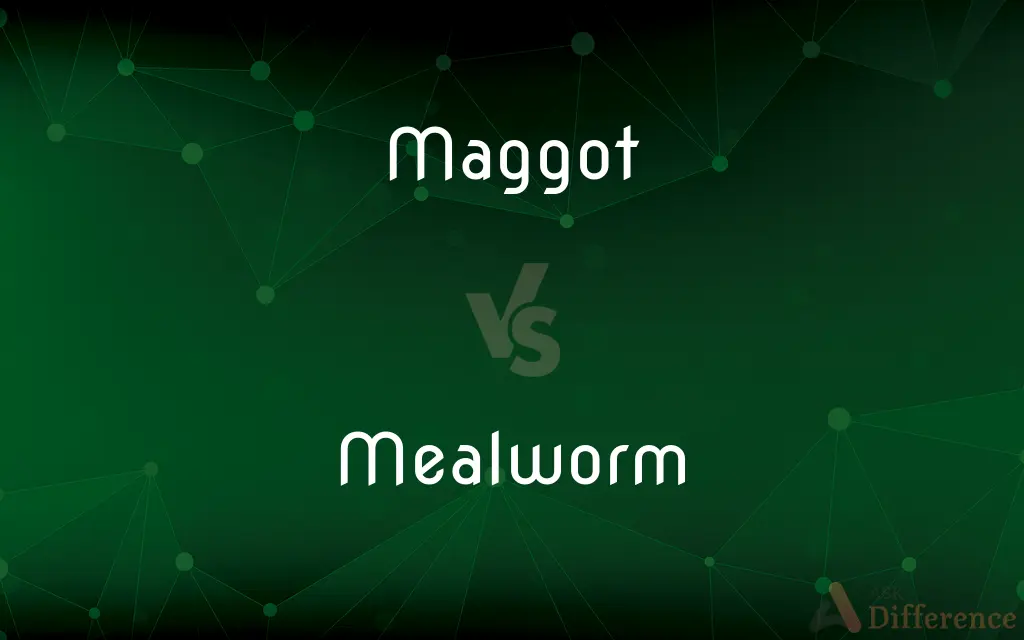Maggot vs. Mealworm — What's the Difference?
By Maham Liaqat & Fiza Rafique — Updated on March 5, 2024
Maggots are fly larvae, thriving in decaying organic matter, often seen in waste management and forensic contexts, while mealworms are beetle larvae, used in animal feed and sustainable human food sources, indicating their distinct ecological roles.

Difference Between Maggot and Mealworm
Table of Contents
ADVERTISEMENT
Key Differences
Maggots, the larvae of flies, primarily decompose organic material, playing a crucial role in nutrient recycling and waste decomposition. They are often associated with decay and are used in medical treatments for wound debridement. On the other hand, mealworms, which are larvae of the mealworm beetle, serve as a high-protein food source for animals and are being explored for human consumption due to their sustainability and nutritional benefits.
While maggots are generally found in moist, decaying environments and are known for their rapid growth and consumption rates, mealworms are reared in controlled conditions, feeding on grains and vegetables. This difference highlights maggots' association with decomposition and mealworms' role in the food chain as a feed and food source.
Maggots have a soft, elongated body without legs, facilitating their movement in their decomposing habitats, whereas mealworms have a harder, cylindrical body with six small legs, making them more adapted to dry environments like grain stores. This morphological difference reflects their respective adaptations to their environments and lifestyles.
Maggots are utilized in waste management to break down organic waste efficiently and in forensic science to estimate the time of criminal investigations. Mealworms, however, are cultivated on a large scale for pet food, fish bait, and increasingly as an alternative protein source in human diets, emphasizing their economic and environmental importance.
Despite their different origins and functions, both maggots and mealworms are integral to their respective ecosystems. Maggots aid in breaking down and recycling dead organic matter, preventing disease spread, while mealworms contribute to sustainable agriculture and food security through their role in animal feed and potential in human nutrition.
ADVERTISEMENT
Comparison Chart
Origin
Larvae of flies (Diptera family)
Larvae of mealworm beetles (Tenebrio molitor)
Habitat
Decaying organic matter, moist environments
Dry environments, stored grains
Role in Ecosystem
Decomposers, nutrient recycling
Feed source, part of sustainable agriculture
Body Features
Soft, legless, elongated
Hard, cylindrical, six small legs
Commercial Use
Waste management, medical, forensic science
Animal feed, sustainable human food source
Compare with Definitions
Maggot
Indicator in forensic analysis.
Forensic entomologists study maggots to estimated time.
Mealworm
Larval stage of the mealworm beetle, used in feed.
Mealworms are a popular choice for reptile pet owners.
Maggot
Associated with rapid growth.
Maggot populations can increase quickly in suitable conditions.
Mealworm
Lives in dry stored grains.
Mealworms are commonly found in improperly stored grain.
Maggot
Larvae stage of a fly, thriving in decay.
Maggots were found decomposing the discarded food.
Mealworm
Sustainable protein source.
Mealworms are being considered as a sustainable protein option for humans.
Maggot
Contributor to waste management.
Maggots play a crucial role in organic waste recycling processes.
Mealworm
Cultivated for animal feed.
Farmers cultivate mealworms to feed poultry and fish.
Maggot
Used in medical treatments for wound cleaning.
Sterile maggots are used for debriding non-healing wounds.
Mealworm
Part of sustainable agriculture.
Mealworm farming contributes to sustainable agricultural practices.
Maggot
A maggot is the larva of a fly (order Diptera); it is applied in particular to the larvae of Brachycera flies, such as houseflies, cheese flies, and blowflies, rather than larvae of the Nematocera, such as mosquitoes and crane flies. A 2012 study estimated the population of maggots in North America to be in excess of 3×1017.
Mealworm
A larva of any of various darkling beetles, especially Tenebrio molitor, which infests flour and other grain products and is often used as food for birds and reptiles and as fish bait.
Maggot
The legless, soft-bodied, wormlike larva of any of various dipteran flies, often found in decaying matter.
Mealworm
The larval stage of the mealworm beetle (Tenebrio molitor), a species of darkling beetle.
Maggot
The footless larva of any fly. See Larval.
Mealworm
The larva of beetles of the family Tenebrionidae
Maggot
The larva of the housefly and blowfly commonly found in decaying organic matter
Common Curiosities
What is a mealworm?
A mealworm is the larval stage of the mealworm beetle, often used as animal feed and explored as a sustainable human food source.
How do maggots and mealworms differ in habitat?
Maggots thrive in moist, decaying environments, whereas mealworms are found in dry conditions like stored grains.
Can both maggots and mealworms be used in human food?
While maggots are generally not considered for human consumption, mealworms are being explored as a sustainable protein source for humans.
What role do maggots play in the ecosystem?
Maggots decompose organic waste, aiding in nutrient recycling and preventing disease spread.
How are mealworms beneficial to sustainable agriculture?
Mealworms serve as a sustainable feed for animals and offer potential as an alternative protein source, reducing reliance on traditional livestock farming.
What is a maggot?
A maggot is the larval stage of a fly, known for its role in decomposing organic material.
Are maggots used in medical treatments?
Yes, sterile maggots are used in some medical treatments to clean wounds by consuming dead tissue.
How do the physical characteristics of maggots and mealworms differ?
Maggots are soft and legless, ideal for their moist habitats, while mealworms have a harder body with six legs, suited for dry environments.
What commercial uses do mealworms have?
Mealworms are commercially raised for pet food, fish bait, and as a sustainable protein source for human diets.
Is mealworm cultivation environmentally friendly?
Yes, mealworm cultivation is considered environmentally friendly due to its low water and land usage compared to traditional livestock.
Why are maggots important in forensic science?
They are used to estimated time by analyzing their development stage and population in decomposing remains.
What distinguishes mealworms as a food source?
Mealworms are rich in protein and nutrients, making them an efficient and sustainable food source.
Are there health risks associated with consuming mealworms?
Properly processed mealworms are safe for consumption, but individuals with shellfish allergies should exercise caution due to similar allergens.
Can maggots be used in waste management?
Maggots are effectively used in organic waste management, breaking down waste rapidly.
How do maggots and mealworms contribute to recycling processes?
Maggots recycle nutrients by decomposing organic matter, while mealworms can help reduce food waste when used as feed in sustainable farming practices.
Share Your Discovery

Previous Comparison
Ingratiating vs. Obsequious
Next Comparison
Clean vs. SpotlessAuthor Spotlight
Written by
Maham LiaqatCo-written by
Fiza RafiqueFiza Rafique is a skilled content writer at AskDifference.com, where she meticulously refines and enhances written pieces. Drawing from her vast editorial expertise, Fiza ensures clarity, accuracy, and precision in every article. Passionate about language, she continually seeks to elevate the quality of content for readers worldwide.
















































